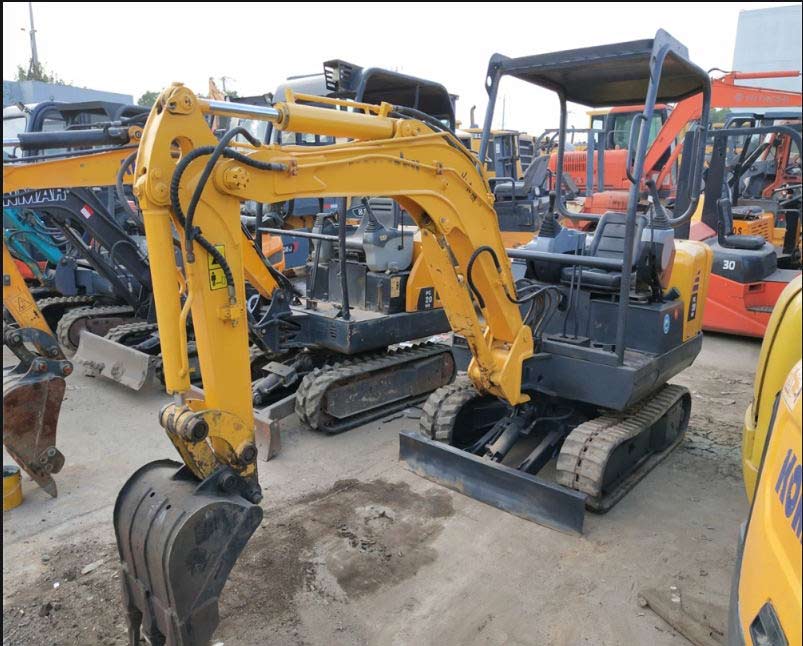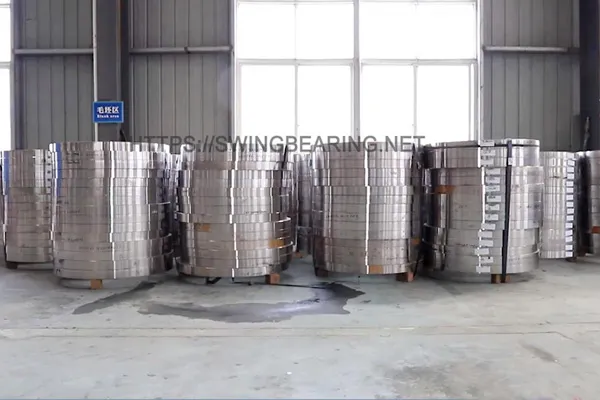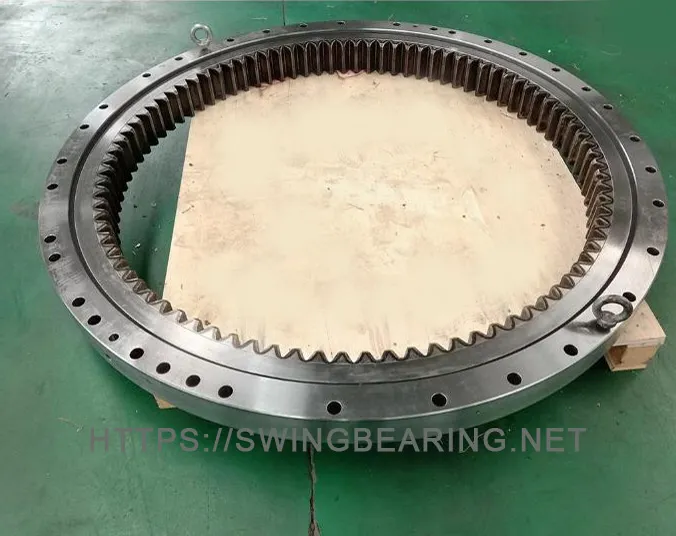
Excavators, particularly those manufactured by industry giant Caterpillar, are pivotal in heavy machinery operations, ranging from construction to mining. The seamless operation of these machines is significantly dependent on the integrity and performance of their swing bearings. These components are crucial for the rotation of the excavator’s upper structure, which directly impacts its versatility and efficiency. Understanding the materials used in constructing these swing bearings is essential for comprehending their durability and performance. In this blog, we will delve into the specific materials that form the foundation of Caterpillar excavator swing bearings, explaining why these materials are chosen and how they contribute to the bearing’s functionality.
Swing bearings, also known as slewing bearings or turntable bearings, play a critical role in the functionality of an excavator. They allow the upper structure to rotate 360 degrees on its base, facilitating the versatile movement required for various tasks. The construction of these bearings involves meticulous engineering and the use of high-quality materials to ensure they can withstand the demanding conditions they operate under.
Alloy steels are the primary materials used in the construction of swing bearings due to their exceptional strength and durability. These steels are enhanced with various alloying elements, such as chromium, nickel, and molybdenum, which significantly improve their mechanical properties.
Chromium-molybdenum steel, commonly referred to as chromoly steel, is a popular choice for swing bearings. The addition of chromium enhances the steel’s hardness and wear resistance, while molybdenum increases its toughness and strength at high temperatures. This combination makes chromoly steel ideal for components subjected to high stress and load conditions, such as swing bearings.
Nickel-alloy steel is another material frequently used in swing bearings. Nickel improves the steel’s toughness, making it more resistant to impact and fatigue. This property is crucial for swing bearings, which must endure constant rotation and heavy loads without failing.
Heat treatment is a vital process in the manufacture of swing bearings. It involves heating the steel to a specific temperature and then cooling it at a controlled rate to alter its microstructure. This process enhances the mechanical properties of the steel, making it more suitable for heavy-duty applications.
Quenching and tempering are common heat treatment processes used for swing bearings. Quenching involves rapidly cooling the heated steel in water or oil to increase its hardness. However, this can also make the steel brittle. To counteract this, tempering is performed, which involves reheating the quenched steel to a lower temperature and then allowing it to cool slowly. This process balances hardness and toughness, creating a material that is both strong and resilient.
Induction hardening is another heat treatment technique used to increase the surface hardness of swing bearings. This process involves heating the surface of the bearing raceways using electromagnetic induction and then rapidly cooling it. The result is a hard, wear-resistant surface with a tough, ductile core, providing an optimal combination of durability and strength.
Swing bearings utilize rolling elements, such as balls or rollers, to facilitate smooth rotation. The choice of material for these elements is crucial as they directly impact the bearing’s performance and lifespan.
High-carbon chromium steel is commonly used for the rolling elements in bantalan ayun. This steel contains a high percentage of carbon and chromium, which enhances its hardness and wear resistance. The high carbon content provides the necessary hardness, while chromium improves corrosion resistance, making these rolling elements durable and long-lasting.
In some high-performance applications, ceramic rolling elements are used. Ceramics, such as silicon nitride, offer several advantages over steel, including higher hardness, lower density, and superior resistance to wear and corrosion. These properties make ceramic rolling elements ideal for applications requiring high precision and long service life, although they are more expensive than their steel counterparts.

Seals are integral components of swing bearings, protecting them from contaminants such as dirt, water, and debris. The material used for seals must be durable and resistant to wear and chemical degradation to ensure long-term protection.
Elastomeric seals, made from materials such as nitrile rubber (NBR) or fluorocarbon rubber (Viton), are commonly used in swing bearings. These materials offer excellent resistance to abrasion, chemicals, and extreme temperatures. Nitrile rubber is known for its good mechanical properties and oil resistance, while Viton provides superior heat and chemical resistance, making it suitable for more demanding applications.
Polyurethane seals are another option for swing bearings, offering a unique combination of toughness, flexibility, and resistance to abrasion and chemicals. These seals are particularly useful in applications where high wear resistance is essential, ensuring the longevity and reliability of the swing bearing.
Proper lubrication is critical for the smooth operation and longevity of swing bearings. The lubrication system ensures that the rolling elements and raceways are adequately lubricated, reducing friction and wear.
Grease is commonly used for lubricating swing bearings due to its excellent adhesion and sealing properties. High-quality, heavy-duty greases are formulated to withstand the extreme pressures and loads encountered by swing bearings. These greases often contain additives such as molybdenum disulfide or graphite to enhance their load-carrying capacity and reduce friction.
In some applications, oil lubrication is preferred due to its superior cooling properties and ability to flow into tight spaces. Oil can be supplied through automatic lubrication systems, ensuring a consistent supply of lubricant to the bearing. These systems often include filtration units to remove contaminants, further extending the bearing’s life.

The manufacturing process of swing bearings involves several critical steps, including forging and machining. High-quality steel billets are forged into the desired shape, enhancing the material’s strength and toughness. Precision machining is then performed to achieve the exact dimensions and tolerances required for the bearing.
Precision grinding is a crucial step in the manufacturing process, ensuring that the raceways are smooth and accurately dimensioned. This process minimizes friction and wear, contributing to the bearing’s smooth operation and long service life.
The final assembly of swing bearings involves carefully fitting the rolling elements and seals into the machined rings. Once assembled, the bearings undergo rigorous testing to ensure they meet the required performance standards. This testing includes checks for dimensional accuracy, load-carrying capacity, and rotational smoothness.
In conclusion, the materials used in the construction of Caterpillar excavator swing bearings are meticulously selected to ensure optimal performance and durability. High-grade alloy steels, advanced heat treatment processes, and specialized materials for rolling elements and seals all contribute to the reliability and longevity of these critical components. Understanding the materials and manufacturing processes behind swing bearings provides valuable insight into their role in facilitating the rotation of an excavator’s upper structure, ensuring efficient and versatile operation.
A1: Caterpillar excavator swing bearings are typically constructed using high-grade alloy steels. These steels are often alloyed with elements such as chromium, nickel, and molybdenum to enhance their mechanical properties. High-carbon chromium steel is commonly used for the rolling elements, while the seals are made from durable elastomeric materials like nitrile rubber or Viton. These materials ensure the bearings can withstand high stress, heavy loads, and harsh operating conditions.
A2: The primary function of swing bearings in Caterpillar excavators is to facilitate the rotation of the excavator’s upper structure. This allows the excavator to rotate 360 degrees on its base, enabling versatile movement and efficient operation. Swing bearings support heavy loads and transmit the rotational forces necessary for the excavator’s movements, playing a crucial role in the machine’s overall performance and efficiency.
A3: Swing bearings in Caterpillar excavators should be inspected and maintained regularly to ensure optimal performance and longevity. It is recommended to perform visual inspections daily and conduct more thorough inspections weekly or monthly, depending on the usage and operating conditions. Key maintenance tasks include checking for signs of wear or damage, ensuring proper lubrication, and inspecting seals for integrity. Regular maintenance helps prevent unexpected failures and extends the bearing’s service life.
A4: Signs of wear or damage in Caterpillar excavator swing bearings include unusual noises during operation, increased vibration, difficulty in rotation, and visible cracks or deformations. Other indicators include excessive play or movement in the bearing and leakage of lubrication. Regular inspections can help identify these signs early, allowing for timely repairs or replacements to prevent further damage and maintain the excavator’s performance.
A5: Using high-quality lubrication in swing bearings provides several benefits, including reducing friction and wear, preventing corrosion, and enhancing the bearing’s overall performance and lifespan. Proper lubrication ensures smooth rotation and minimizes the risk of overheating and mechanical failure. High-quality lubricants often contain additives that improve their load-carrying capacity and resistance to extreme temperatures, making them ideal for the demanding conditions in which Caterpillar excavators operate. Regular lubrication maintenance is essential to ensure these benefits are consistently realized.